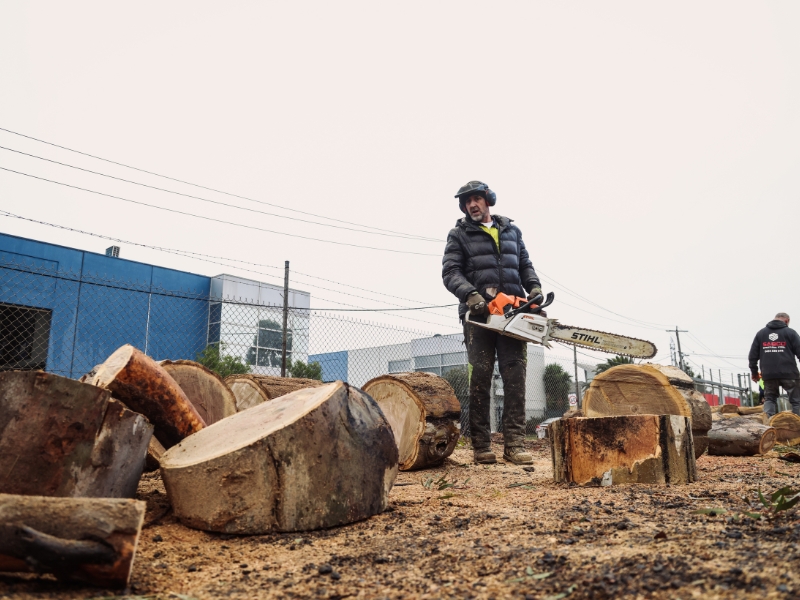When it comes to stump grinding, many factors influence the cost, but the type of tree often plays a major role. Understanding how different tree species impact the process can help you budget more effectively and make informed decisions. Let’s dive into the details and explore the various elements that determine stump grinding expenses.
What factors determine stump grinding costs?
The cost of stump grinding varies depending on several factors, with tree species being just one consideration. Here are the key elements that influence pricing:
- Stump Size – Larger stumps demand more time and effort to grind.
- Wood Density – Harder woods require more robust equipment and effort.
- Root System – Complex root systems add to the workload.
- Stump Age – Older stumps are often easier to grind due to natural decay.
- Location – Accessibility challenges or proximity to structures may raise costs.
- Tools and Equipment – Specialised machinery can be required for certain jobs.
Each of these factors plays a role in shaping the final price and the difficulty of the task.
How does wood density affect stump grinding?
Wood density directly impacts the effort required to grind a stump. Dense woods like eucalyptus or ironbark take longer to process and wear down equipment faster. In contrast, softer woods such as pine or cedar are much easier to grind.
Key considerations:
- Hardwoods require more time, effort, and equipment maintenance, which can increase costs.
- Softwoods are less dense, resulting in faster and more affordable grinding.
The type of wood in question can significantly influence the overall expense.
Are native and non-native trees priced differently for stump grinding?
In regions like Melbourne, native and non-native trees can have different impacts on stump grinding costs. Native species often have unique characteristics, such as denser wood or more intricate root systems, which can make the grinding process more laborious.
Things to keep in mind:
- Native trees like gum trees or wattles can have dense wood and widespread roots.
- Non-native species, such as poplars or birches, may be simpler to grind.
- Environmental factors and local regulations might also play a role in handling native trees.
Understanding the tree type helps in estimating the complexity and cost of grinding the stump.
Why does root system complexity matter?
The complexity of a tree’s root system significantly affects the stump-grinding process. Some trees develop deep, extensive roots that are challenging to remove, while others have more compact systems that simplify the task.
Key factors:
- Shallow roots are generally easier and faster to grind.
- Deep and widespread roots require extra effort and time to handle.
- Root systems near structures or underground utilities demand greater precision.
A thorough evaluation of the root system is crucial for efficiently managing the stump grinding process and costs. Moreover, to effectively manage tree care, it’s important to understand the impact of climate change on tree health. Fluctuating weather patterns can affect a tree’s health and stability, potentially leading to more frequent removals or stump grinding.
Does stump age influence grinding difficulty?
The age of the stump plays an important role in determining how challenging it is to grind. Freshly cut stumps are typically harder to grind because the wood is still solid and intact. In comparison, older stumps may be partially decomposed, making the grinding process easier.
Consider these points:
- Fresh stumps with robust roots are tougher to process.
- Decayed stumps are often softer, reducing grinding time and effort.
- The condition of the stump can also affect the durability of the equipment used.
Assessing the stump’s age and condition ensures a smoother and more efficient process.
How does tree size correlate with stump grinding expenses?
Tree size is one of the most straightforward factors affecting stump grinding costs. Larger stumps require more time, effort, and equipment power to grind down completely. For those looking for a cost-effective tree stump removal solution, smaller trees with less extensive root systems typically result in lower grinding expenses, as they require less time and effort to remove.
Key factors:
- Height and diameter directly impact the duration and difficulty of the task.
- Larger trees often have more extensive root systems, increasing complexity.
- Grinding tools may need to be adjusted or upgraded for larger stumps.
Tree size is a critical element to consider when budgeting for stump grinding.
What role does location play in stump grinding costs?
Location can significantly influence stump grinding expenses. Stumps in open areas are generally easier to access and grind. At the same time, those in tight or challenging locations may require additional effort and specialised equipment.
Points to consider:
- Urban environments often involve obstacles like fences, patios, or utilities.
- Remote or uneven terrain can make the task more physically demanding.
- Proximity to structures requires extra caution to avoid property damage.
Furthermore, the ideal season for stump removal is typically during the cooler months, as the ground is firmer. This makes it easier to access and grind stumps efficiently without the added challenge of wet or soft soil. Ensuring the stump is easily accessible can help keep costs under control.
How can professional arborists help reduce stump grinding challenges?
Engaging professional arborists ensures that stump grinding is performed efficiently and safely, reducing potential challenges. Their expertise, combined with access to advanced tools, can simplify even the most complex jobs. Benefits of professional stump grinding services:
- Expert Assessment – Identifying key factors like tree species, stump size, and root complexity.
- Specialised Equipment – Handling dense wood and tricky locations with the right tools.
- Safety Standards – Minimising risks to property, people, and the environment.
- Permit Assistance – Navigating local regulations for tree removal and stump grinding.
Professional arborists deliver peace of mind and a streamlined process for property owners.
Don’t let stumps ruin your yard
Dealing with stumps doesn’t have to be a headache. Whether you’re tackling a stubborn gum tree stump or clearing space for a new project, The Yard offers professional stump grinding services tailored to your needs.
With qualified arborists, state-of-the-art equipment, and a focus on safety and compliance, The Yard is Melbourne’s trusted partner for tree care. Our team ensure every job is completed efficiently, safely, and with minimal disruption to your property.
Take the first step today—get in touch with The Yard today and experience the difference that expertise and customer care can make in managing your tree and stump needs.




